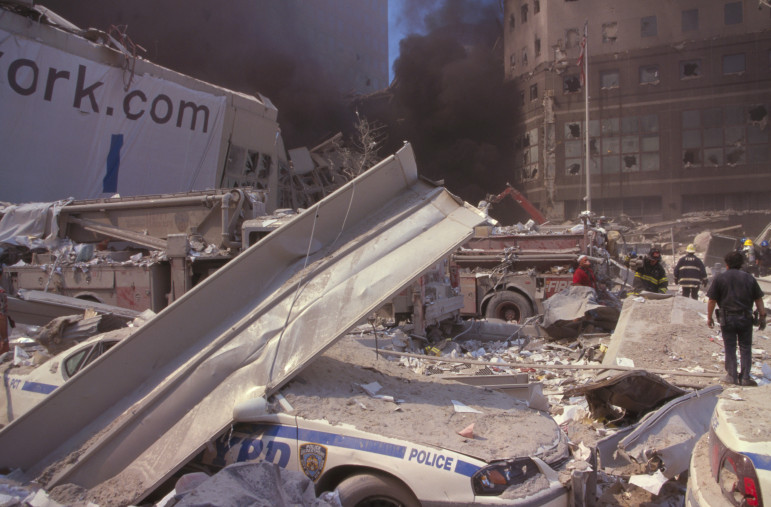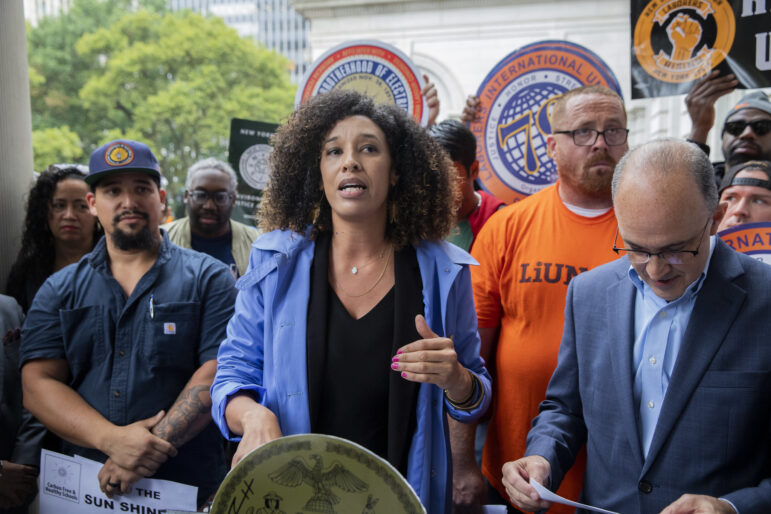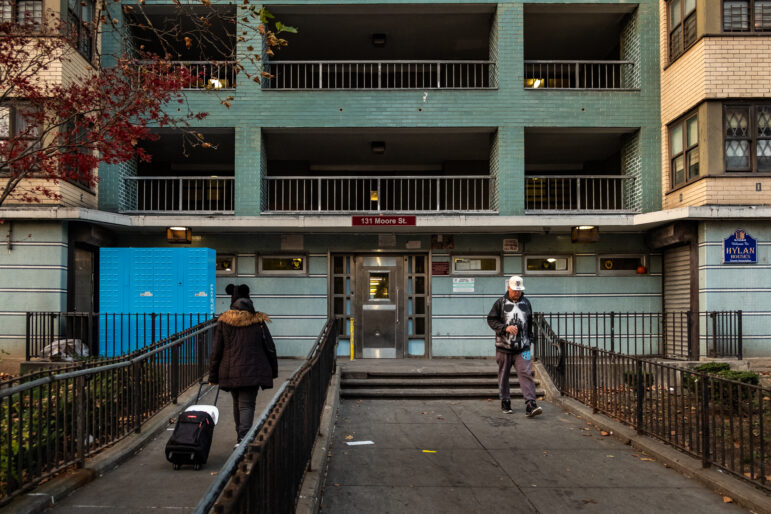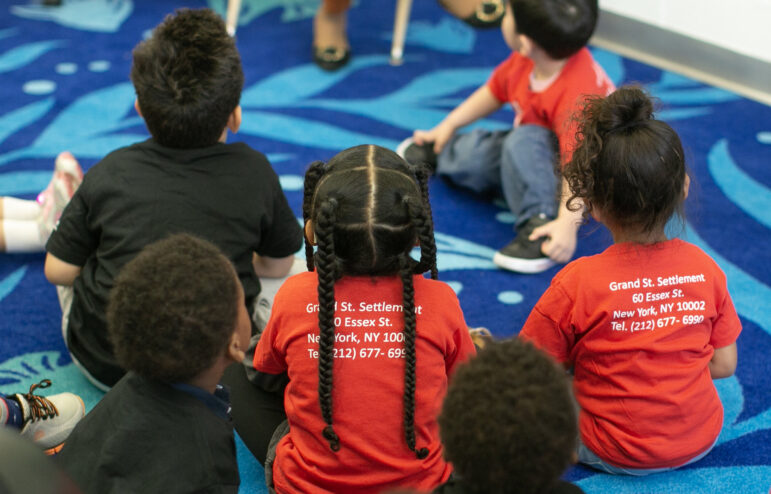
NYDA
Integrity monitors played an important part in post-9/11 rebuilding, keeping an eye out for corruption as tons of debris were carted away at public expense.
This is the first part in a three-part series on the successes, failures and questions that surround the integrity monitoring industry in New York.
* * * *
The accepted narrative is that after years of concerted efforts by federal and state prosecutors organized crime has lost its strangle hold on New York City’s construction industry and on the unions that provided the Mafia’s “in.” In its place are multinational construction companies, an army of sub-contractors and reformed unions, all kept in line by a group of self-styled “integrity monitors” who were former prosecutors in the vanguard of the anti-mob effort.
Thanks to their role in that Mafia eradication effort, and as highly valued sources for the media for decades, the integrity monitors are now widely quoted as the preeminent experts in the field. They have also spawned a multi-million dollar consulting sector that they say keeps corruption out, old buildings coming down and new shiny ones going up.
These former prosecutors are no longer government employees or law enforcement agents though, they know how to navigate that realm very well. They are often funded by the very companies they have under scrutiny. Depending on the situation, they can report to the client the construction company is working for, a sitting judge, a law enforcement agency like the City’s Department of Investigation, or even the construction company itself.
But there are a handful of critics of this arrangement who say the integrity monitors can be co-opted and can become captive to the multibillion dollar industry they police.
The need for integrity monitoring is likely only to increase as the city takes on huge projects to gird against climate change and create a massive amount of affordable housing.
If the past 15 years are any guide, as that work progresses, some integrity monitors will succeed at preventing problems, as they did in the demolition and reconstruction of the World Trade Center. Others will catch serious issues in time for corrective action to occur, as occurred in the recent scandal over concrete testing at city sites.
But sometimes, corruption or a callous regard for human life will win, with deadly consequences. Such was the case of the decontamination and deconstruction of the Deutsche Bank at 130 Liberty Street, adjacent to the World Trade Center site.
A range of tasks
The monitor’s assignment can include insuring that companies abide by the deferred prosecution agreements they have entered into with prosecutors. The monitors can also see to it that the company in question abides by, or creates an internal compliance program to institutionalize whatever reforms the company has committed itself to making. In cases where the company’s past business relationships have proven problematic the monitor serves as a back stop to insure the company doesn’t revert to past patterns of behavior that got in trouble in the first place.
When it comes to site safety and construction quality, the City’s Department of Buildings, the FDNY, the New York State Department of Labor as well as the Federal Government’s Occupational Hazards and Safety Administration, OSHA, all have an important role in the oversight of the construction industry. The private monitors are a critical extra layer of pro-active monitoring on top of that existing overlay of municipal, state and even Federal regulation.
Currently the New York City Department of Investigation has 14 monitorships that range from the ongoing Department of Environmental Protection’s construction of the Croton Filtration Plant to the City’s troubled Sandy “Build it Back Program.” In addition to project-specific monitorships companies like the Louis Berger engineering company and the Metropolitan Coordinating Council on Jewish Poverty, a charity are under DOI mandated monitorships. But the DOI is not the only entity assigning independent monitors. Both state and Federal prosecutors can require them as part of a settlement with an entity that finds itself on the wrong side of the law. Companies can also independently hire a monitor as a proactive measure against additional reputation damage done by an internal scandal or breach of public trust that does not rise to the level of criminality.
According to the Center for an Urban Future the City has more than $34 billion dollars in unfunded capital projects for 18 City agencies like New York City Housing Authority which makes up $14 billion of the gap. Our hospitals, schools, and transportation infrastructure all need a massive infusion of capital spending. As the Bloomberg Administration left office a $20 billon dollar estimate surfaced for the cost of preparing the City for climate change. Add to the mix Mayor de Blasio’s commitment to add 200,000 affordable and low income housing units–a $41 billion dollar initiative. Taken together, the city’s to-do list presents a litany of potential safety problems and of opportunities for corruption that will pad the price-tag and reduce what actually gets done.
The presence of integrity monitors, in and of themselves, is no guarantee that a project can’t be compromised.
Nor is it uncommon for companies with checkered pasts to be involved in major public projects. Consider the May 2012 WNBC investigation that revealed 10 of the city’s top 25 public works were being done by companies with criminal histories or poor safety record.
An industry rises
In some ways, integrity monitors sit at the juncture of New York’s present and its past. On one side is the new and shiny post-911 New York, flush with development money and hell-bent on building the stadiums and high-rises that had been impossible dreams during the long post-fiscal crisis convalescence. On the other was the seedy echo of days when the mob ran construction in New York City. Connecting the two eras were the integrity monitors, born from that dirty history.
In April of 1988 Vincent (the Fish) Cafaro, a top lieutenant in the Genovese crime family, told a riveted U.S. Senate committee that the mob controlled 75 percent of the construction industry via its stranglehold on the concrete industry and the building trades unions. Cafaro described in detail how the mafia families leveraged their dominance to rig construction bids so as to require every successful bidder pay a tribute to the self styled cartel. The so called “2 percent club” pulled in millions and New York City enjoyed the reputation as a place where construction costs would be as high as the mob wanted them to be. On occasion the mob would resort to violence to re-enforce their control.
The hidden tax and perennial cost overruns knee-capped the ability of the public sector to keep up with upgrading an infrastructure that hadn’t seen really big investment since LaGuardia and Roosevelt. It also kept out minority participation in a dynamic business sector that would surpass manufacturing. There were also lost opportunity costs for the whole city when developers would consider other cities to invest in because the price the “2 percent club” extracted was just too high.
Throughout the 1980s and early 90s’s Ronald Goldstock served as the Director of the New York State Organized Crime Task Force—up to that point the state’s highest profile campaign to rid the construction industry of mob control. Goldstock was the lead author of “Corruption and Racketeering in the NYC Construction Industry Final Report,” a seminal tome issued by his agency. The New York Times said the document marked “the first time that a government agency has warned that important management and labor elements in the city’s multibillion-dollar industry have accommodated themselves to the Mafia’s corruption and racketeering practices.”
Goldstock is currently the New York State Commissioner of the Waterfront Commission on NY Harbor. While at the Organized Crime Task Force, he says, he developed the concept of the Independent Private Sector Inspector General. In addition to his part-time assignment as a Waterfront Commissioner, Goldstock works for private corporate clients. He says that IPSIGs have to be independent of the company they are working with and of the governmental entity to which they may report.
“Your obligation is to the truth not to the government or the company,” Goldstock says. “It’s not just about being a cop but looking to change the culture of the entity so it is less likely that criminal activity will occur.”
Toby Thacher II was a co-author of the watershed OCTF construction industry report and worked with Goldstock on the high-profile task force. He went on to become the vice-president and inspector general for the New York City School Construction Authority. Gov. Mario Cuomo had committed a billion dollars annually for five years for a long overdue upgrade of the city’s public schools that had fallen into disrepair. Thacher, from his post at the NYCSA, had a mandate to keep the school construction work beyond the reach of organized crime. As a result 220 companies were disqualified from bidding on the school construction.
Thacher says that the use of independent integrity monitors were part of his strategy at the SCA, which was hailed by the media as a way to keep the construction trades on the up and up but the industry functioning. “The focus should be on preventing the commission of crimes by using prosecutorial tools and insights to design business strategies to reduce the opportunities and incentives to act corruptly,” Thacher says.
In 1996 Thacher went into the private sector and for the next 17 years his firm became the go-to company for integrity monitoring and regulatory compliance for the construction and real estate industry. In 2012 he and his firm merged with K-2 Intelligence, a global investigative and integrity consulting firm that was established by Jeremy and Jules Kroll.
Tracing his history back even further is Ed Stier, who believes he was the first private sector integrity monitor. For 17 years, Stier served as both a state and federal prosecutor. As the director of New Jersey’s Division of Criminal Justice and as an assistant US Attorney he specialized in complex white-collar and organized-crime investigations and spearheaded some of the most important criminal cases of his generation.
His initial assignment as a private monitor was working with General Public Utility in the aftermath of the Three Miles Island near meltdown in 1979. GPU was still under national scrutiny after the worst nuclear power accident in the history of the country. The utility pled guilty to federal charges including the falsification of records and brought in Stier. His team did a comprehensive review of the utility’s operations to flush out any corner cutting.
“We determined it was more pervasive then the feds had realized,” Stier recalled. “But the company had promised that every detail of our report would be made public and as a consequence GPU became more transparent.”
Back in May of 1987 Stier was appointed to monitor for New Jersey’s notorious Teamster Local 560 that had been run by mafia boss Anthony Provenzano, who was convicted of murder in 1978. Stier kept an eye on Local 560 for 12 years until a Federal judge was convinced the local no longer was under the influence of organized crime. 1999, Stier and his team were hired by Jimmy Hoffa Jr. to be integrity monitors for the entire Teamster union, which was lobbying hard to end ten years of Department of Justice oversight.
In 2004 he threw in the towel on the national Teamster monitoring—a high profile and lucrative assignment. He told a reporter at the time he was unable to get the union leadership to follow up on what he thought they needed to do to truly reform the Teamster culture. “I have seen it happen where integrity monitors end up working strictly for a company with a checkered past and they get co-opted , they become captive,” says Stier told City Limits.
Thacher, Goldstock and Stier are just a few of the integrity monitors or “independent inspectors general” whose resumes include time in the trenches during New York’s battle with the mob. That noble background has helped them sniff out trouble in some cases. It has also shielded them for public or prosecutorial scrutiny in others.









2 thoughts on “Monitors with Mixed Record to Play Key Role in Vital NYC Projects”
The biggest scam is HPD’s inspectors and NYCHDC inspectors for buildings. Seems it’s like an Abbott & Costello episode when the HPD inspector comes to your building year after year and there is still the same construction defects, mold and leaky roofs. NYCHDC has NO tracking mechanism when it comes to new buildings, or recently built buildings and developers. The corruption is that the developers seem to be all connected to REBNY and are donors to gov Cuomo.
Another big scam is the monitors on the Atlantic Yards project hired by the developer and Empire State Development. Really who’s monitoring this fiasco?